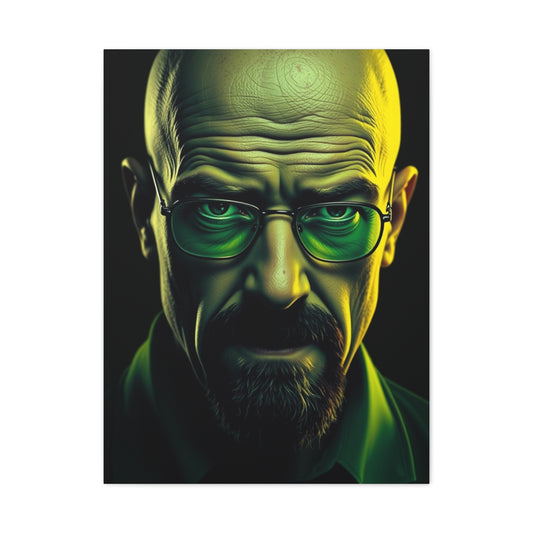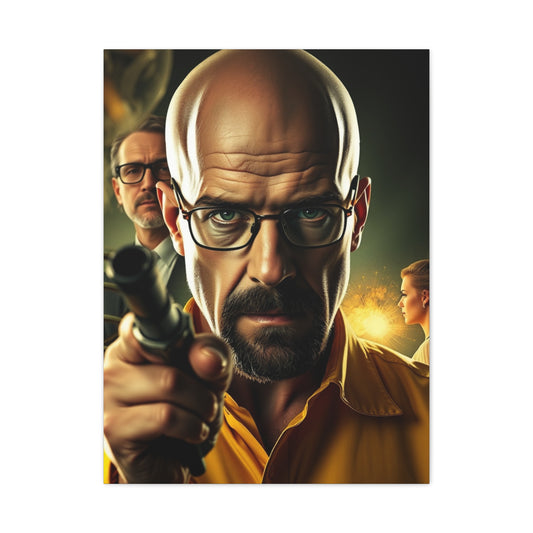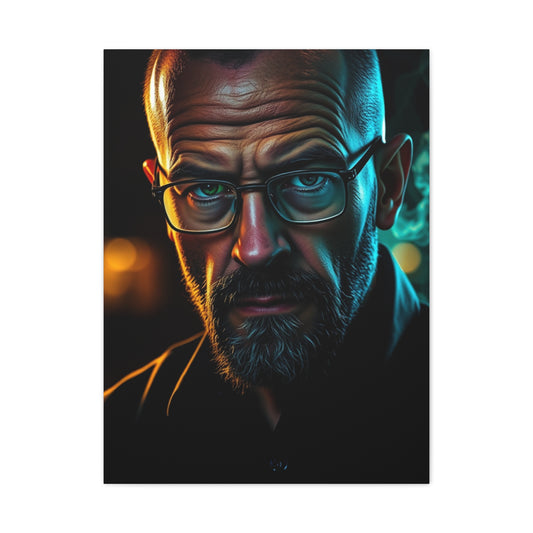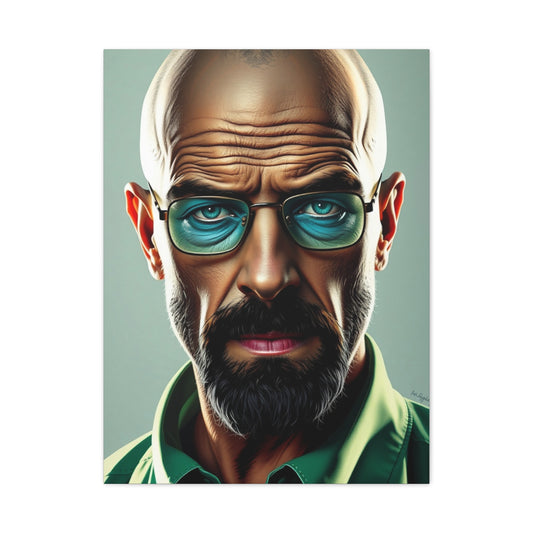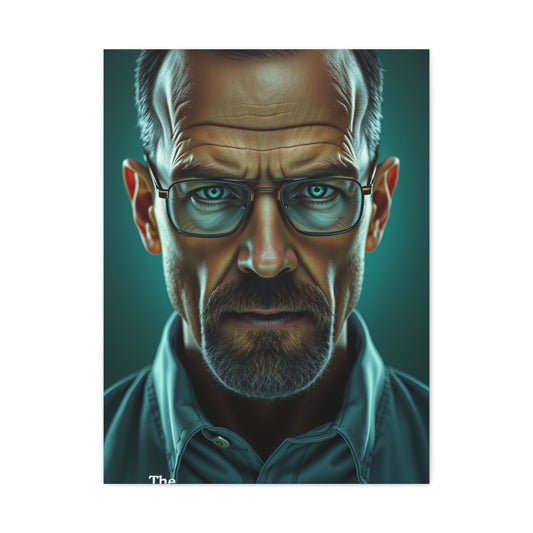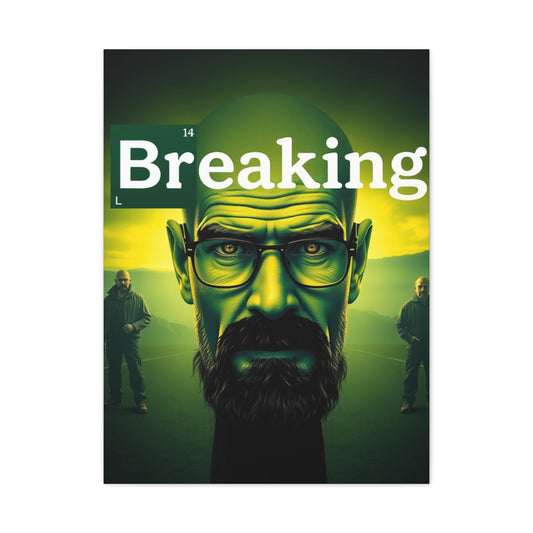Breaking Bad Minimalist Wall Art Collection
The world of visual culture has undergone dramatic transformations as creative artists continue to reinterpret iconic works of entertainment through new perspectives. Among the most captivating artistic approaches to emerge in recent decades is the creation of minimalist posters, which distill the essence of a story into clear, refined, and impactful visuals. This design movement has gained remarkable traction among enthusiasts, collectors, and interior design lovers, particularly when it comes to reimagining beloved television series. The phenomenon illustrates how a careful balance of reduction and symbolism can deliver powerful impressions, sparking both aesthetic admiration and emotional connection.
Breaking Bad, one of the most groundbreaking series in television history, has provided a fertile foundation for this style of artistic exploration. Revered for its complex characters, morally intricate narratives, and visually striking cinematography, the series remains a treasure trove for illustrators seeking to translate its spirit into poster art. Minimalist interpretations of Breaking Bad often focus on singular objects, colors, or silhouettes—small details that fans instantly associate with pivotal moments. A simple sketch of Walter White’s fedora, the crystalline blue of his infamous product, or the unmistakable shape of a gas mask can immediately transport viewers back into the show’s layered universe.
The enduring popularity of these posters lies in their ability to compress vast storytelling into minimal strokes. Unlike conventional posters that rely on elaborate details, minimalist designs highlight symbolic resonance. By stripping away excess imagery, artists challenge viewers to engage with their own memories and interpretations of the narrative. This interactivity makes the posters far more than just decorative items—they become conversation starters, nostalgic triggers, and timeless expressions of visual storytelling.
Minimalist Breaking Bad posters also demonstrate the artistic power of restraint. Instead of overwhelming a space with visual noise, these works thrive on clarity and simplicity. A room decorated with such posters communicates sophistication, intentionality, and cultural appreciation. The limited use of color, balanced composition, and thoughtful abstraction make them suitable for diverse environments—from modern apartments to creative offices, studios, and galleries. Their clean aesthetic aligns with contemporary design preferences that value functionality, harmony, and elegance without sacrificing individuality.
Beyond their decorative role, these posters carry cultural weight. Breaking Bad’s impact extends far beyond television; it has become an enduring cultural phenomenon that continues to influence art, fashion, and design. Minimalist posters capture this legacy, ensuring that the series’ iconic moments and characters live on in new artistic forms. Each poster becomes a bridge between television and fine art, allowing fans to celebrate the series while embracing a visual style that resonates with broader trends in creativity and design.
Collectors, in particular, find deep value in these pieces. Limited-edition prints and artist collaborations transform them into highly sought-after items, blending the worlds of fandom and art investment. The rarity of certain designs and the distinctiveness of each artist’s interpretation add layers of uniqueness, making the act of collecting as meaningful as the artwork itself. For many, owning a minimalist Breaking Bad poster is more than possessing décor—it represents holding a piece of cultural history reimagined through a contemporary artistic lens.
The appeal of minimalist episode posters also lies in their universality. Even individuals who may not be avid television enthusiasts can appreciate the artistry behind these creations. Their pared-down elegance allows them to stand independently as striking works of design while simultaneously carrying deep resonance for fans familiar with the source material. This duality—being both accessible and profoundly meaningful—is one of the strongest testaments to the enduring influence of minimalist art.
Revolutionary Approach to Television Series Artwork
Minimalist poster design for television episodes has emerged as a groundbreaking artistic approach that bridges the worlds of fine art and popular culture. In an era when television storytelling rivals the complexity of cinema and literature, fans and artists alike have sought new ways to honor and interpret their favorite series. Minimalist artwork offers a distinctive path—one that strips away visual excess to reveal the pure emotional and thematic essence of an episode.
The core philosophy behind minimalist poster design is reduction without loss of meaning. Artists working in this style deliberately avoid cluttered visuals, instead distilling entire narratives into a single image or symbolic representation. This could be as subtle as a silhouette, a recurring object, or a fragment of setting that encapsulates the mood of the episode. For example, an episode filled with tension and secrecy might be represented through the image of a keyhole or a single dimly lit window. While deceptively simple, such visuals invite audiences to recall and re-experience the layered storytelling that inspired them.
What makes this approach revolutionary is not only its aesthetic clarity but also its participatory quality. Minimalist posters do not spoon-feed every detail; instead, they rely on the viewer’s own memory and emotional connection to fill in the gaps. This creates a dialogue between art and audience, where personal interpretation enhances the appreciation of the work. In many ways, it mirrors the way television itself leaves space for speculation, anticipation, and discussion among fans.
The growing popularity of minimalist television artwork also reflects a broader cultural shift. Television has long outgrown its reputation as mere entertainment and is now recognized as a legitimate form of modern storytelling. By translating episodes into collectible, gallery-worthy art pieces, minimalist designers elevate the medium into a realm typically reserved for cinema or literature. This transformation affirms the cultural importance of television in shaping narratives, identities, and shared experiences.
Beyond its artistic merit, minimalist poster design offers practical appeal. Unlike heavily detailed fan art that can sometimes feel overwhelming, minimalist designs suit modern interiors, blending seamlessly into contemporary homes or offices. They function as both cultural tributes and sophisticated décor, appealing to fans who want to display their passion without compromising aesthetic sensibilities.
In essence, minimalist television posters serve as more than mere memorabilia. They are visual poems—condensed, elegant, and evocative—reminding us of the power of simplicity in capturing complex stories. By transforming beloved episodes into iconic symbols, this movement redefines how popular culture can be celebrated, appreciated, and preserved through the timeless language of art.
Distinguished Comic Artist's Television Tribute
Francesco Francavilla, one of the most celebrated figures in modern comic book artistry, has successfully bridged the worlds of sequential storytelling and television-inspired artwork through his minimalist poster series for Breaking Bad. Known for his bold use of color, cinematic framing, and atmospheric compositions, Francavilla has long been regarded as a master of visual storytelling. His foray into creating artwork based on individual episodes of Breaking Bad demonstrates both his versatility as an artist and his deep appreciation for narrative-driven art forms.
Francavilla’s extensive background in the comic book industry laid the foundation for this artistic tribute. Over the years, he has contributed to some of the most iconic titles in the industry, including Captain America and Daredevil for Marvel Comics, as well as Detective Comics and Swamp Thing for DC Comics. Each of these works required not only artistic precision but also an ability to convey layered emotions, character psychology, and narrative progression through static visuals. This skill set naturally lends itself to the reinterpretation of television episodes, where a single moment or symbol can embody the emotional weight of an entire storyline.
In his Breaking Bad poster series, Francavilla showcases his mastery of minimalist visual compression. Each piece distills an episode down to its essential thematic or symbolic core, allowing audiences to recognize the narrative instantly while also engaging their own memories of the show. For instance, rather than overwhelming viewers with every detail of a plot, Francavilla isolates key motifs—a gas mask, a barrel, a desert silhouette—that evoke both the mood and tension of the corresponding episode. His use of bold, contrasting colors paired with noir-inspired shadows creates a haunting aesthetic that perfectly mirrors the moral ambiguity and escalating danger that define Breaking Bad.
What sets Francavilla’s work apart is his ability to balance fan tribute with high artistic merit. Many television-inspired artworks lean heavily on nostalgia, but Francavilla’s posters elevate the material into pieces that stand on their own as contemporary art. They function simultaneously as collectible memorabilia for fans and as striking, stylish wall art suitable for gallery spaces.
Ultimately, Francavilla’s Breaking Bad tribute underscores the powerful connection between comics, television, and fine art. By applying his comic book storytelling expertise to a celebrated television series, he has created a body of work that not only honors the legacy of Breaking Bad but also demonstrates how visual art can reinterpret and extend the cultural resonance of narrative media. His posters invite viewers to revisit the series, not through passive rewatching, but through active, interpretive engagement with the imagery that defined its most unforgettable moments.
Comprehensive Episode Coverage Strategy
Francesco Francavilla’s Breaking Bad poster collection reflects a carefully considered approach to scope and selection rather than an attempt to create a piece for every single episode. Instead of producing a uniform series that covers all five seasons in exhaustive detail, he strategically focuses on particular seasons and story arcs that offer the richest material for minimalist reinterpretation. This deliberate curation ensures that each poster stands as a refined, self-contained work of art while collectively forming a cohesive narrative journey through the series.
By concentrating on the first two seasons, Francavilla captures the foundational stages of Breaking Bad’s storytelling. These early episodes are crucial because they establish Walter White’s transformation from an unassuming chemistry teacher into someone willing to break societal and moral boundaries. Moments of foreshadowing, symbolic imagery, and character introductions in these seasons provide abundant material for a minimalist artist to distill into single, impactful images. Through carefully chosen visual metaphors—such as chemistry equipment, desert landscapes, or signature props—the posters capture the essence of these formative chapters without requiring literal detail.
Equally significant is Francavilla’s choice to complement the beginning of the narrative with artwork from the latter half of the final season. This decision creates a striking visual and thematic dialogue between the origins of the story and its eventual conclusion. The juxtaposition of early and late episodes highlights the full scope of character evolution and moral descent that defines the series. Viewers can appreciate not only the stark differences in tone and imagery between the beginning and the end but also the subtle continuities that run throughout the show’s arc. The posters become markers of transformation, charting Walter White’s progression and the shifting dynamics of those around him.
This selective approach also reveals Francavilla’s commitment to quality over quantity. By avoiding the pressure to cover every episode, he allows each chosen piece to be crafted with deliberate attention and emotional resonance. The resulting collection feels purposeful rather than exhaustive, emphasizing the most impactful turning points in the narrative. For collectors and fans, this focus enhances the artwork’s value, making the posters not only tributes to specific episodes but also symbolic representations of the show’s broader themes—ambition, morality, identity, and consequence.
Ultimately, Francavilla’s episode coverage strategy demonstrates a deep understanding of both artistic integrity and narrative significance. His choices allow the posters to function as more than decorative pieces; they serve as interpretive reflections of Breaking Bad’s storytelling power, bridging its beginnings and its conclusion through minimalist yet emotionally charged design.
Minimalist Design Philosophy in Entertainment Art
The philosophy of minimalism in art, particularly when applied to entertainment-related creations, is far more than a stylistic preference—it is a refined approach to communication through design. By distilling imagery to its purest, most essential elements, minimalist art strips away excess and allows viewers to focus entirely on the core message or emotion. Within the world of entertainment, where stories are often layered with complex narratives, symbolism, and character development, minimalist art functions as a striking counterpoint. It reduces complexity without diminishing meaning, offering a fresh lens through which to appreciate beloved shows and films.
When applied to television series artwork, minimalism carries a unique strength. Rather than overwhelming the viewer with intricate detail or multiple visual cues, minimalist designs lean on simplicity to provoke recognition and emotional resonance. A single object, a carefully chosen color, or a subtle geometric shape can communicate entire seasons of storytelling. The viewer’s mind, trained by memory and emotional connection, fills in the missing details, making the artwork interactive in a psychological sense. For fans of iconic shows, this becomes a deeply engaging experience, where recognition is both immediate and rewarding.
The process of crafting minimalist posters or artwork for entertainment requires much more than artistic skill—it demands analytical precision. Designers must sift through expansive source material to determine which aspects hold the greatest symbolic weight. For example, an iconic prop, a repeated visual motif, or even a silhouette of a character might become the centerpiece of a poster. This curation process is critical because minimalism thrives on exclusion: the fewer elements used, the more important each one becomes. Every line, shape, and shade must serve a deliberate purpose.
Beyond mere reduction, minimalist entertainment art aims for balance between symbolic meaning and aesthetic appeal. Artists must ensure that their designs not only resonate with long-time fans but also carry standalone artistic value. Someone unfamiliar with the show should still find the piece visually compelling, even if the deeper symbolism escapes them. Achieving this duality requires mastery of composition, scale, and color psychology. A thoughtfully selected color palette, for instance, can embody the mood of an entire series—dark, muted tones for a gritty crime drama, or bright, contrasting hues for a lighthearted comedy.
Another significant challenge lies in recognizability. Unlike traditional posters that rely heavily on character portraits, quotes, or detailed scenery, minimalist posters often communicate through suggestion. This means the artist must carefully calibrate their choices so that fans immediately connect the artwork to the source material. Too abstract, and the connection is lost; too literal, and the minimalist spirit is compromised. The most effective pieces strike a delicate balance, leaving just enough for the audience to recognize while still preserving the clean, distilled aesthetic that defines minimalism.
Color Theory and Atmospheric Mood Creation
One of the most critical elements in Francesco Francavilla’s Breaking Bad minimalist poster series is his masterful use of color. In the realm of minimalist design, where extraneous detail is stripped away, color often becomes the central tool for communicating tone, emotion, and narrative essence. Breaking Bad itself is a show remembered not only for its storytelling and performances but also for its distinctive and deliberate use of color throughout the series. From the arid desert landscapes with their sun-drenched ochres and browns to the sterile grays of industrial spaces and the sudden shock of vivid accents—such as blood reds, toxic greens, or the infamous blue of Heisenberg’s meth—the visual palette of the show provides fertile ground for artistic reinterpretation.
Francavilla harnesses these established visual cues while simultaneously infusing his own creative refinements. For example, warm hues such as burnt orange, crimson, and dusty yellow can convey the heat, danger, and escalating tension that permeate episodes centered on violence or moral corruption. Conversely, muted blues, grays, and greens often evoke feelings of despair, solitude, or cold calculation, aligning with episodes that explore Walter White’s growing detachment from his humanity. This ability to match palette to narrative creates posters that not only recall the episodes themselves but also amplify their emotional weight through purely visual means.
Color psychology lies at the heart of this effectiveness. Minimalist art requires that each visual choice perform multiple narrative functions simultaneously, and Francavilla demonstrates an acute awareness of how certain hues resonate with audiences on an instinctual level. A poster featuring a deep, blood-red background may instantly recall themes of sacrifice or violence, while a stark black-and-white design with a single accent color can crystallize an entire character arc into one unforgettable image. Through careful balancing of saturation, contrast, and tone, Francavilla ensures that the atmosphere of each episode is distilled into a single striking composition.
What makes his approach especially impactful is the interplay between color and mood. The posters are not mere decorative tributes but atmospheric windows into Breaking Bad’s moral universe. A viewer looking at one of Francavilla’s designs can almost feel the heat of the desert sun, the chill of an abandoned meth lab, or the suffocating tension of a climactic confrontation—all through color alone. This capacity to evoke sensory and emotional experiences without detailed representation is the mark of a true minimalist master.
Ultimately, Francavilla’s use of color transforms each poster into more than a promotional piece; it becomes a mood-driven artwork that engages memory and emotion. His strategic palette choices bridge the gap between narrative and visual design, ensuring that even in their stripped-down form, the posters remain deeply faithful to the emotional intensity of Breaking Bad.
Symbolic Representation and Visual Metaphor
Minimalist poster design thrives on the power of suggestion, relying less on literal depictions and more on symbolic representation and visual metaphor to convey meaning. Instead of reproducing detailed character portraits or elaborate scenes, minimalist art distills narratives into elemental forms that speak volumes through simplicity. This approach emphasizes the importance of symbols—objects, shapes, colors, or silhouettes—that embody deeper narrative or emotional significance. By using metaphorical imagery, the artwork communicates not just what viewers see on screen, but the themes, conflicts, and emotions that underpin the story.
In the realm of Breaking Bad minimalist posters, symbolism takes on a particularly potent role. The series is rich with recurring motifs—chemistry equipment, the color green, a pink teddy bear, or even something as ordinary as a box cutter—that carry immense thematic weight. A minimalist poster might feature only a gas mask, yet for fans it immediately evokes the tension of clandestine meth production, the dangers of toxic ambition, and the transformation of Walter White from teacher to kingpin. Similarly, a single silhouette of Heisenberg’s hat and glasses is enough to conjure the entire identity shift that drives the series. Through such carefully chosen visuals, complex ideas are distilled into single, powerful images.
The challenge for the artist lies in selecting symbols that not only carry narrative importance but also resonate on multiple interpretive levels. An effective symbol should reward both casual and devoted viewers. For someone unfamiliar with the show, a poster featuring a fly might seem intriguing in its simplicity, while for fans it recalls the famous “Fly” episode and its deeper commentary on obsession, guilt, and control. This dual accessibility elevates minimalist posters from fan memorabilia to standalone works of art that communicate across different audiences.
Visual metaphor adds another layer of sophistication. Whereas a symbol directly references an object or theme, a metaphor transforms imagery into broader commentary. For example, a cracked Erlenmeyer flask might not only represent Walter’s scientific background but also symbolize the fragility of his moral compass. A desert horizon fading into nothingness could signify both the show’s physical setting and the emptiness at the heart of Walter’s ambition. These metaphors allow minimalist posters to transcend literal storytelling, offering interpretations that echo the moral and psychological dimensions of the series.
Consistency of symbolic language across a poster series is equally important. A collection that represents each Breaking Bad episode with its own minimalist poster gains cohesion when visual metaphors align stylistically and thematically. For example, using a restricted color palette—such as bold yellows, deep blacks, and stark whites—creates unity while still allowing each poster to highlight unique symbolic elements. Repetition of certain motifs across the collection, like chemical formulas or desert landscapes, establishes continuity while reinforcing the show’s overarching themes. This symbolic vocabulary builds a dialogue between individual episodes, reminding viewers of how the story’s moments interconnect to form a larger narrative.
Technical Excellence in Illustration Execution
The technical aspects of minimalist poster creation demand high levels of artistic skill and attention to detail, despite the apparently simple final results. Professional illustrators working in this medium must demonstrate mastery of composition, line quality, color application, and digital or traditional media techniques. The apparent simplicity of minimalist artwork often conceals sophisticated technical execution that requires years of professional development and practice.
Digital illustration tools have revolutionized the creation of minimalist poster art, providing artists with unprecedented control over color accuracy, line precision, and compositional refinement. However, the availability of advanced digital tools does not diminish the importance of fundamental artistic skills and design understanding. Successful minimalist posters result from the combination of technical proficiency and conceptual sophistication that characterizes professional-level artistic practice.
The printing and reproduction considerations for minimalist poster artwork require careful attention to technical specifications and quality control measures. Colors must translate accurately from digital files to physical prints, and line weights must remain crisp and defined across various printing scales. These technical requirements influence design decisions from the earliest conceptual stages through final production.
Cultural Impact and Fan Community Response
The creation and distribution of minimalist television poster series has generated significant interest within fan communities and broader cultural discussions about the intersection of fine art and popular entertainment. These artistic interpretations provide new avenues for fan engagement while elevating the cultural status of television programming through association with sophisticated visual art practices.
Fan community response to high-quality artistic interpretations of beloved television series often demonstrates the depth of emotional connection that audiences develop with exceptional programming. Minimalist poster collections become objects of desire not just for their aesthetic qualities but also for their ability to represent personal relationships with fictional characters and narratives. This emotional investment drives market demand and encourages continued artistic exploration of television subjects.
The broader cultural implications of treating television series as subjects worthy of serious artistic interpretation reflect evolving attitudes toward popular entertainment and its cultural significance. As television programming achieves new levels of narrative sophistication and production quality, artistic responses naturally follow, creating feedback loops that enhance the cultural value of both the original programming and its artistic interpretations.
Collectibility and Market Dynamics
The market for television-related artwork, particularly high-quality minimalist poster series, has experienced significant growth as collectors recognize both aesthetic and investment potential in well-executed pieces. Limited edition releases, artist signatures, and printing quality all contribute to the collectible value of minimalist television posters. Understanding these market dynamics helps both artists and collectors make informed decisions about creation and acquisition strategies.
Print run limitations and exclusivity marketing strategies have become standard practices in the television artwork market, creating artificial scarcity that drives collector interest and secondary market values. However, the long-term value of such pieces ultimately depends on the enduring popularity of the source material and the artistic quality of the interpretations themselves.
The emergence of online marketplaces and digital distribution channels has democratized access to television artwork while creating new challenges for artists seeking to maintain control over their work and receive appropriate compensation. Balancing accessibility with exclusivity remains an ongoing challenge for artists working in this growing market segment.
Integration with Contemporary Interior Design
Minimalist television poster artwork has found increasing acceptance in contemporary interior design applications, where the clean aesthetics and sophisticated color palettes complement modern decorating trends. The ability of well-designed minimalist posters to function both as fan tributes and legitimate art pieces makes them valuable additions to diverse decorating schemes.
Interior design professionals have begun incorporating television-related artwork into residential and commercial projects, recognizing that high-quality pieces can enhance spatial aesthetics while reflecting client personalities and interests. This professional acceptance represents a significant shift in attitudes toward popular culture-derived artwork and its place in sophisticated design environments.
The scale and format considerations for minimalist television posters must account for various display contexts, from intimate residential spaces to large commercial installations. Successful pieces maintain visual impact across different scales while preserving the essential simplicity that defines effective minimalist design.
Artistic Legacy and Future Developments
The establishment of minimalist television poster art as a legitimate artistic category opens possibilities for future developments and expanded exploration of television subjects. As more artists recognize the creative potential in television interpretation, we can expect continued innovation in approach, technique, and conceptual sophistication.
The influence of pioneering work in television poster art may inspire new generations of artists to explore similar themes and approaches, potentially leading to the development of distinct artistic movements or schools focused on popular culture interpretation. This evolutionary process mirrors historical developments in art movements that have emerged in response to cultural phenomena and technological changes.
Long-term preservation and documentation of television poster artwork becomes increasingly important as these pieces gain cultural and historical significance. Museums, galleries, and private collections must develop appropriate conservation strategies to ensure that future generations can appreciate both the artistic merit and cultural context of these works.
Technical Innovation in Digital Art Production
The advancement of digital art production technologies continues to expand possibilities for minimalist poster creation, offering artists new tools for precision, efficiency, and creative exploration. Vector graphics software, advanced color management systems, and high-resolution display technologies all contribute to the technical excellence achievable in contemporary minimalist artwork.
Artificial intelligence and machine learning technologies may eventually influence minimalist poster creation processes, though the essential creative vision and conceptual development will likely remain fundamentally human endeavors. The integration of technological assistance with artistic creativity presents interesting possibilities for future artistic development.
The democratization of high-quality digital art tools has enabled more artists to explore minimalist television poster creation, potentially leading to increased competition but also greater diversity in artistic approaches and interpretations. This expanded participation enriches the overall artistic landscape while challenging established artists to maintain excellence and innovation.
Educational Value and Artistic Appreciation
Minimalist television poster collections serve important educational functions, introducing viewers to design principles, color theory, and symbolic representation through engaging subject matter. Educational institutions have begun incorporating popular culture artwork analysis into visual arts curricula, recognizing the pedagogical value of studying familiar subjects through artistic interpretation.
The analysis of effective minimalist poster design can enhance general visual literacy skills while providing accessible entry points for broader art appreciation. Students and general audiences often find television-related artwork more approachable than traditional fine art subjects, creating opportunities for meaningful engagement with sophisticated design concepts.
Art criticism and academic analysis of television poster artwork contributes to broader understanding of contemporary art movements and their relationship to popular culture. Scholarly examination of these works helps establish critical frameworks for evaluation and appreciation while documenting cultural phenomena for future study.
Global Influence and Cultural Exchange
The international popularity of quality television programming has created global audiences for minimalist poster artwork, leading to cross-cultural exchange of artistic approaches and aesthetic preferences. Artists from different cultural backgrounds bring unique perspectives to television interpretation, enriching the overall artistic landscape through diverse viewpoints and techniques.
Digital distribution and social media platforms have facilitated international sharing of television poster artwork, allowing artists to reach global audiences and receive feedback from diverse cultural perspectives. This international exposure can influence artistic development while spreading appreciation for both the original television programming and its artistic interpretations.
The cultural translation challenges involved in creating television poster artwork for international audiences require sensitivity to different symbolic systems and aesthetic preferences. Successful pieces often achieve universal appeal through careful attention to cross-cultural communication principles and inclusive design approaches.
Professional Development and Career Opportunities
The growing market for television-related artwork has created new professional opportunities for illustrators, graphic designers, and fine artists seeking to develop careers in popular culture interpretation. Understanding market demands, audience preferences, and technical requirements becomes essential for professional success in this expanding field.
Portfolio development for television artwork specialists requires demonstration of both artistic skill and cultural understanding, showing ability to interpret complex narrative material through sophisticated visual design. Professional networking within fan communities, entertainment industry circles, and fine art markets all contribute to career development in this specialized field.
The balance between artistic integrity and commercial viability presents ongoing challenges for professional artists working in television interpretation. Successful careers often depend on maintaining high artistic standards while remaining responsive to market demands and audience preferences.
Preservation and Archival Considerations
The long-term preservation of digital television poster artwork requires careful attention to file format standards, color management protocols, and backup storage systems. As these pieces gain historical and cultural significance, proper archival practices become essential for ensuring future accessibility and study opportunities.
Physical print preservation involves traditional conservation challenges related to paper quality, ink stability, and environmental control. Collectors and institutions must develop appropriate storage and display protocols to maintain artwork condition over extended periods.
Documentation of artistic processes, conceptual development, and cultural context surrounding television poster creation provides valuable resources for future researchers and art historians. Artists and collectors should consider maintaining comprehensive records that enhance understanding of these works beyond their immediate aesthetic impact.
Conclusion
The artistic interpretation of television programming through minimalist poster design represents a fascinating convergence of contemporary art practices and popular culture appreciation. Francesco Francavilla's exceptional Breaking Bad poster collection exemplifies the sophisticated artistic achievement possible when talented professionals apply their skills to television subject matter. His background in comic book illustration provides unique advantages in approaching narrative compression and symbolic representation, resulting in artwork that successfully bridges the gap between fan appreciation and legitimate artistic expression.
The minimalist approach to television poster design demonstrates the power of reduction and symbolic representation in creating emotionally resonant artwork. By focusing on essential visual elements while eliminating superfluous details, artists can capture the essence of complex episodes through singular, impactful images that communicate both immediate visual satisfaction and deeper thematic understanding. This artistic philosophy aligns perfectly with contemporary design trends while honoring the sophisticated storytelling that characterizes exceptional television programming.
The cultural significance of high-quality television poster artwork extends beyond simple fan merchandise, contributing to broader discussions about the intersection of fine art and popular entertainment. As television programming achieves new levels of narrative sophistication and production excellence, artistic responses naturally follow, creating feedback loops that enhance the cultural value of both original programming and its artistic interpretations. This cultural elevation reflects evolving attitudes toward popular entertainment and its legitimate place within contemporary artistic discourse.
The technical excellence required for effective minimalist poster creation demands professional-level skills in composition, color theory, digital illustration, and print production. Despite their apparently simple final appearance, successful minimalist posters result from sophisticated technical execution combined with deep conceptual understanding of both source material and visual communication principles. This combination of technical proficiency and artistic vision distinguishes professional-quality work from amateur attempts.
The market dynamics surrounding television artwork collections demonstrate growing collector interest and investment potential in well-executed pieces. Limited edition releases, artist recognition, and printing quality all contribute to the long-term value of minimalist television posters. However, sustainable market growth depends on maintaining artistic quality standards while meeting collector demands for both aesthetic satisfaction and cultural significance.
The integration of television poster artwork into contemporary interior design applications reflects broader acceptance of popular culture-derived art in sophisticated decorating contexts. Professional interior designers increasingly recognize that high-quality pieces can enhance spatial aesthetics while reflecting client personalities and interests. This professional acceptance represents significant progress in attitudes toward entertainment-related artwork and its place in refined design environments.
Looking toward future developments, the establishment of minimalist television poster art as a legitimate artistic category opens possibilities for continued innovation and expanded exploration. As more artists recognize the creative potential in television interpretation, we can expect ongoing advancement in technique, conceptual sophistication, and cultural impact. Educational applications of television poster analysis provide accessible entry points for broader art appreciation while contributing to visual literacy development.
In summary, the minimalist poster interpretation of Breaking Bad episodes represents outstanding artistic achievement that successfully honors exceptional television programming while contributing to contemporary art discourse. The combination of technical excellence, conceptual sophistication, and cultural relevance demonstrates the significant artistic potential available when talented professionals engage seriously with popular entertainment subjects. This artistic approach provides valuable cultural contributions while offering collectors and enthusiasts meaningful ways to celebrate and preserve their appreciation for exceptional television storytelling.


